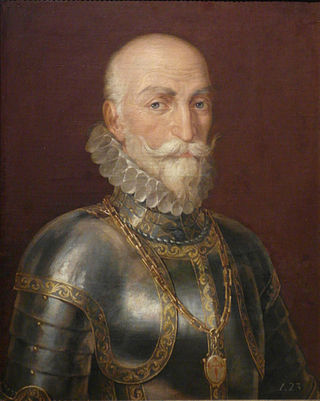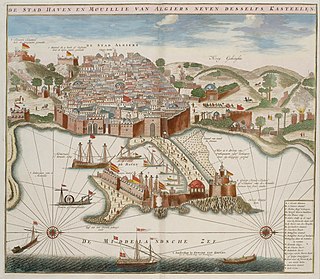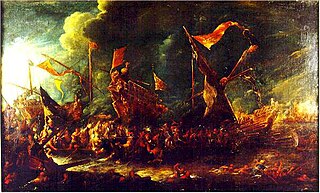
The Battle of Lepanto was a naval engagement that took place on 7 October 1571 when a fleet of the Holy League, a coalition of Catholic states arranged by Pope Pius V, inflicted a major defeat on the fleet of the Ottoman Empire in the Gulf of Patras. The Ottoman forces were sailing westward from their naval station in Lepanto when they met the fleet of the Holy League which was sailing east from Messina, Sicily.

Galleons were large, multi-decked sailing ships developed in Spain and first used as armed cargo carriers by Europeans from the 16th to 18th centuries during the Age of Sail and were the principal vessels drafted for use as warships until the Anglo-Dutch Wars of the mid-17th century. Galleons generally carried three or more masts with a lateen fore-and-aft rig on the rear masts, were carvel built with a prominent squared off raised stern, and used square-rigged sail plans on their fore-mast and main-masts.

The Holy League of 1571 was arranged by Pope Pius V and included the major Catholic powers of southern Europe, specifically the Spanish Empire as well as the Italian maritime powers. It was intended to break the Ottoman Empire’s control of the eastern Mediterranean Sea and was formally concluded on 25 May 1571.

The Action of 8 July 1716 was an indecisive naval battle that took place on 8 July 1716 during a Turkish attempt to capture the island of Corfu (Kerkyra), off the west coast of mainland Greece.

The action of 3 October 1624 was a naval engagement that took place near San Pietro Island, Sardinia, during the war against the Barbary corsairs. A squadron of galleys from the Spain, Grand Duchy of Tuscany and Papal States under Diego Pimentel engaged a squadron of six Algerian ships under Azan Calafate. The Algerians were defeated, their flagship was destroyed, and four ships were captured. Also, the Christian slaves they owned were freed.

Álvaro de Bazán y Guzmán, 1st Marquis of Santa Cruz, was a Spanish admiral and landlord. He took part, among others, in the seizure of the rock of Vélez de la Gomera (1564), the relief to the besieged during the Great Siege of Malta (1565), the quelling of the Alpujarras Rebellion (1569), the Battle of Lepanto (1571), the conquest of Tunis (1573), the incorporation of Portugal to the Hispanic monarchy (1580), and the conquest of Terceira (1582).

The Battle of Gibraltar took place on 10 August 1621, during the Eighty Years' War between the Spanish Empire and the Dutch Republic. A Dutch East India Company fleet, escorted by a squadron under Willem Haultain de Zoete, was intercepted and defeated by nine ships of Spain's Atlantic fleet under Fadrique de Toledo while passing the Strait of Gibraltar.

The siege of Castelnuovo was an engagement during the Ottoman-Habsburg struggle for control of the Mediterranean, which took place in July 1539 at the walled town of Castelnuovo, present-day Herceg Novi, Montenegro. Castelnuovo had been conquered by elements of various Spanish tercios the year before during the failed campaign of the Holy League against the Ottoman Empire in Eastern Mediterranean waters. The walled town was besieged by land and sea by a powerful Ottoman army under Hayreddin Barbarossa, who offered an honourable surrender to the defenders. These terms were rejected by the Spanish commanding officer Francisco de Sarmiento and his captains even though they knew that the Holy League's fleet, defeated at the Battle of Preveza, could not relieve them. During the siege, Barbarossa's army suffered heavy losses due to the stubborn resistance of Sarmiento's men. Even the Venetian refused the promised naval link to Castelnuovo with the supplies and reinforcements; after a general troop parliament, the commanding officer Francisco de Sarmiento asked his captains what his answer should be to Barbarossa's offer to surrender. The captains responded: "Que vengan cuando quieran". However, Castelnuovo eventually fell into Ottoman hands and almost all the Spanish defenders, including Sarmiento, were killed. The loss of the town ended the Christian attempt to regain control of the Eastern Mediterranean. The courage displayed by the Old Tercio of Naples during this last stand, however, was praised and admired throughout Europe and was the subject of numerous poems and songs.

The Battle of Orbetello, also known as the Battle of Isola del Giglio, was a major naval engagement of the Franco-Spanish War of 1635. It was fought on 14 June 1646 off the Spanish-ruled town of Orbetello, on the coast of Tuscany, Italy, between a French fleet led by Admiral Armand de Maillé, Marquis of Brézé, and a Spanish fleet commanded by Miguel de Noronha, 4th Count of Linhares sent to break the blockade of Orbetello and relieve the town, besieged since 12 May by a French army under the command of Prince Thomas of Savoy. The Battle of Orbetello was tactically very unusual, since it was fought by sailing ships towed by galleys in a light breeze.

The battle of Alboran took place on 1 October 1540 off the isle of Alboran during the Ottoman-Habsburg struggle for control of the Mediterranean when a Spanish fleet under the command of Bernardino de Mendoza destroyed an Ottoman fleet commanded by Ali Hamet, sinking a galley and capturing 10 other ships.

The 2nd Bombardment of Algiers took place between 12 and 21 July 1784. A joint Spanish-Neapolitan-Maltese-Portuguese fleet commanded by the Spanish Admiral Antonio Barceló bombarded the city, which was the main base of the Barbary corsairs, with the aim of forcing them to interrupt their activities. The second bombardment followed a similarly failed expedition the preceding year.

The Battle of Cape Corvo was a naval engagement of the Ottoman–Habsburg wars fought as part of the struggle for the control of the Mediterranean. It took place in August 1613 near the island of Samos when a Spanish squadron from Sicily, under Admiral Ottavio d'Aragona, engaged an Ottoman fleet led by Sinari Pasha. The Spanish were victorious and captured seven galleys and about 600 prisoners, among them the Bey of Alexandria and another 60 important Ottoman nobles. Cape Corvo was the first major victory of the Spanish fleets under Pedro Téllez-Girón, 3rd Duke of Osuna, the Spanish Viceroy of Sicily, as well as the greatest Spanish victory over the Ottoman Empire since the Battle of Lepanto.
The Battle of Tarragona of August 1641 was a naval battle that took place between 20 – 25 August 1641, between the Spanish and French fleets during the French stage of the Thirty Years' War. The Spanish fleet, led by the Duke of Fernandina and the Duke of Maqueda broke the French naval blockade of Tarragona and defeated the French fleet under Henri d'Escoubleau de Sourdis, forcing it to retreat. The city was also besieged by land since April by a Franco-Catalan army commanded by Philippe de La Mothe-Houdancourt. The Spanish success in driving Sourdis out of the area, together with the arrival of a relief force sent by land, forced the Franco-Catalan army to leave the siege, and to retreat to Valls, pursued by the Spanish army.

A patache is a type of sailing vessel with two masts, very light and shallow, a sort of cross between a brig and a schooner, which originally was a warship, being intended for surveillance and inspection of the coasts and ports. It was used as a tender to the fleet of vessels of more importance or size, and also for trans-Pacific travel, but later began to be used for trading voyages, carrying cargo burdens of 30 tons or more.

Francisco Díaz Pimienta (1594–1652) was a Spanish naval officer who became Captain general of the Ocean Fleet.

The Battle of the Narrow Seas, also known as the Battle of the Goodwin Sands or Battle of the Dover Straits was a naval engagement that took place on 3–4 October 1602 during the Anglo-Spanish War of 1585 and part of the Dutch Revolt. An English fleet under Sir Robert Mansell intercepted and attacked six Spanish galleys under the command of Federico Spinola in the Dover Straits. The battle was fought initially off the coast of England and finally off the Spanish Netherlands. The English were soon joined by a Dutch fleet under Jan Adriaanszoon Cant, and they completed the destruction.

The Battle of Cape St. Vincent was a naval engagement that took place on 16 June or 6 October 1606, during Eighty Years' War and Dutch–Portuguese War. A Spanish fleet under Admiral Luis Fajardo attacked the Dutch fleet led by Admiral Willem Haultain and Vice Admiral Regnier Klaazoon, which was blocking the Spanish-Portuguese coast to intercept the Spanish treasure fleet. The battle concluded in a Spanish victory; in which Klaazoon's flagship was destroyed, two ships were captured, and Haultain fled with the rest of the fleet to his country without having achieved his purpose.

The Capture of the galleon Lion Couronné was a naval engagement that took place off Formentera on 17 June 1651, during the Franco-Spanish War (1635–1659). A squadron of eleven Spanish galleys under John of Austria the Younger captured the French galleon Lion Couronné after a fight.

The Conquest of Tunis in 1573 was a Spanish campaign led by John of Austria to conquer Tunis.



















